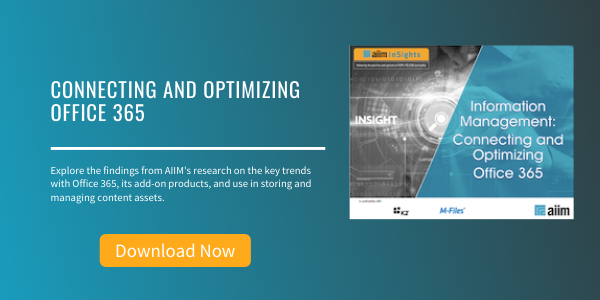
7 Key Data Points about SharePoint 2016
 In A Tale of Two Cities, Charles Dickens famously wrote, “It was the best of times, it was the worst of times…it was the season of Light, it was the season of Darkness, it was the spring of hope, it was the winter of despair.” As I read through the results of our latest SharePoint research, a kind of Dickensian déjà vu washes over me relative to surveys of past years.
In A Tale of Two Cities, Charles Dickens famously wrote, “It was the best of times, it was the worst of times…it was the season of Light, it was the season of Darkness, it was the spring of hope, it was the winter of despair.” As I read through the results of our latest SharePoint research, a kind of Dickensian déjà vu washes over me relative to surveys of past years.
Yes, SharePoint is ubiquitous in most large scale enterprises. Yes, those pesky users, frustrated by usability and mobility issues, are still end-running the IT uber-lords and using consumer technologies to get their jobs done. Yes, SharePoint sophistication varies widely, ranging from those still using it only for basic project file sharing (really? why would you do this?) to those running complicated and mission-critical workflows upon it. Yes, folks are far too often still faking it when it comes to actually operationalizing those elegant governance policies in their SharePoint environment. And yes, enterprises at scale typically lag at least one – and often more than one – version behind the latest version.
It seems like I’ve written this post before. I can anticipate the comments.
"AIIM, you aren’t critical enough about SharePoint!"
"AIIM, you are too critical about SharePoint!"
"We can’t wait to port everything to the cloud!"
"We can’t let anything go to the cloud!"
"We love SharePoint!"
"We hate SharePoint!"
Oh, and BTW the comment from most organizations at scale, "We’re still committed to it."
I think this kind of bipolarity is what one should expect when you ask questions about a platform. As I’ve said many times before, SharePoint has said from the start that it was a platform, not an application. But far too often, when IT folks over the years said “platform, platform, platform” with regards to SharePoint, many of us on the business side heard “application, application, application.”
A couple of points to consider about platforms.
- Satisfaction with platforms depends a lot on what and how people build upon the platform.
- Platforms are only optimized when organizations have the internal resources to support the platform and understand how to do so.
- Platforms are optimized when the business realizes that purchasing the platform is just the beginning. Third-party add-ons and expertise are critical to maximizing value.
- There is a significant knowledge gap at the enterprise level between usage of SharePoint (see below -- for 28%, it's their only or main ECM system) and understanding of where the platform is going (only 23% understand what SharePoint 2016 offers). This gap is a recipe for an unsatisfying project experience.
So check out all of the details in our new SharePoint research. There’s some great stuff it in.
Here are just 7 of my favorite data points:
- SharePoint is the only or main ECM/DM system for 28% of organizations. Thirteen percent see SharePoint as important for their overall ECM/DM environment.
- Eleven percent of organizations have reached a plateau in terms of SharePoint adoption. 22% say their SharePoint adoption is facing challenges from the user community.
- More than a quarter of respondents say they are still using SharePoint 2010, with 41% citing they are using SharePoint 2013 as their live primary version. At this time, only 2% say they are live with SharePoint 2016 and 19% with SharePoint Office 365.
- When it comes to the enhancements found in SharePoint 2016, 43% say they are somewhat aware of what SharePoint 2016 offers, while 29% indicate they have no awareness at all.
- Only 23% of respondents indicate they understand what SharePoint 2016 offers.
- Forty percent of organizations say their SharePoint implementation was not a success. Inadequate user training (67%), hard to use (65%), and lack of senior management support (64%) are cited as reasons for SharePoint projects stalling or failing.
- When looking at SharePoint as an ECM/DM solution, 43% prefer using their file-share application for everyday content. Looking at SharePoint from a process and enterprise connectivity perspective, 72% of organizations show no support for mobile device use.
About John Mancini
John Mancini is the President of Content Results, LLC and the Past President of AIIM. He is a well-known author, speaker, and advisor on information management, digital transformation and intelligent automation. John is a frequent keynote speaker and author of more than 30 eBooks on a variety of topics. He can be found on Twitter, LinkedIn and Facebook as jmancini77. Recent keynote topics include: The Stairway to Digital Transformation Navigating Disruptive Waters — 4 Things You Need to Know to Build Your Digital Transformation Strategy Getting Ahead of the Digital Transformation Curve Viewing Information Management Through a New Lens Digital Disruption: 6 Strategies to Avoid Being “Blockbustered” Specialties: Keynote speaker and writer on AI, RPA, intelligent Information Management, Intelligent Automation and Digital Transformation. Consensus-building with Boards to create strategic focus, action, and accountability. Extensive public speaking and public relations work Conversant and experienced in major technology issues and trends. Expert on inbound and content marketing, particularly in an association environment and on the Hubspot platform. John is a Phi Beta Kappa graduate of the College of William and Mary, and holds an M.A. in Public Policy from the Woodrow Wilson School at Princeton University.



